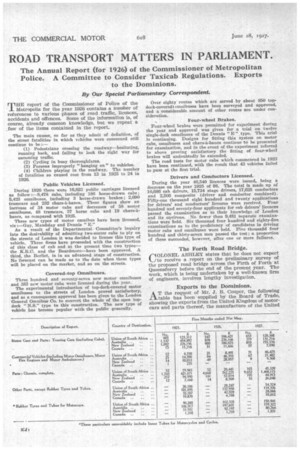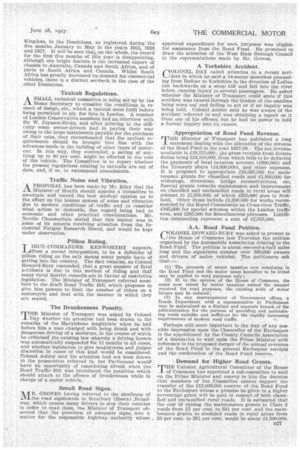ROAD TRANSPORT MATTERS IN PARLIAMENT.
Page 44

Page 45

If you've noticed an error in this article please click here to report it so we can fix it.
The Annual Report (for 1926) of the Commissioner of Metropolitan Police. A Committee to Consider Taxicab Regulations. Exports to the Dominions.
By Our Special Parliamentary Correspondent.
THE report of the Commissioner of Police of the Metropolis for the year 1926 contains a number of references to various phases of road traffic, licences, accidents and offences. Some of the information is, of course, already common knowledge, but we repeat a ,few of the items contained in the report.
The main causes, so far as they admit of definition, of the street fatalities in which vehicles were concerned still continue to be : (1) Pedestrians crossing the roadway-hesitating, running back, and failing to look the right way for oncoming traffic.
(2) Cycling in busy thoroughfares.
(3) Persons improperly "hanging on" to vehicles.
(4) Children playing in the roadway. The number of fatalities so caused rose from 13 in 1925 to 24 in 1926;
Public Vehicles Licensed.
During 1926 there were 16,823 public carriages licensed as follow :--8,478 cabs, including 186 horse-drawn cabs ; 5,423 omnibuses, including 3 horse-drawn brakes ; 2,690 tramcars and 232 chars-d-bancs. These figures show an increase of 34 motor cabs and decreases of 58 motor omnibuses, 48 tramcars, 37 horse cabs and 19 chars-abases, as compared with 1925.
Three new types of motor omnibus have been licensed, viz :-Guy, Mandslay and Dennis "E."
As a result of the Departmental Committee's inquiry into the desirability of admitting two-seater cabs to ply on the streets of London it was decided to license this type of vehicle, Three firms have proceeded with the construction of this class of cab and at the present time two typesthe KIt O. and the Beardmore-have been approved. A third, the Berliet, is in an advanced stage of construction. No forecast can be made as to the date when these types will be placed on the market, and so on the streets.
Covered-top Omnibuses.
Three hundred and seventy-seven new motor omnibuses and 383 new motor cabs were licensed during the year.
The experimental introduction of top-deck-covered motor omnibuses to the streets of London proved satisfactory, and as a consequence approval has been given to the London General Omnibus Co. to convert the whole of the open topdeck "N.S." type to this construction. The new type of vehicle has become popular with the public generally.
Over eighty routes which are served by about 850 topdeck-covered) omnibuses have been surveyed and approved, and a considerable amount of other routes are under consideration.
Four-wheel Brakes.
Four-wheel brakes were permitted for experiment during the year and approval was given for a trial on twelve single-deck omnibuses of the Dennis "E" type. This trialis continuing. Designs for fitting this system on motor cabs, omnibuses and chars-à-bancs continue to be presented for examination, and in the event of the experiment referred to above proving satisfactory the fitting of four-wheel brakes will undoubtedly be extended.
The road tests for motor cabs which commenced in 1923 have been continued, with the result that 43 vehicles failed to pass at the first trial.
Drivers and Conductors Licensed.
During the year 46,540 licences were issued, being a decrease on the year 1925 of 98. The total is made up of 10,686 cab drivers, 15,724 stage drivers, 17,625 conductors and 2,505 composite (driver and conductor combined). rifty-one thousand eight hundred and twenty applications for drivers' and conductors' licences were received. Four hundred and seventy-four applicants for cab drivers' licences passed the examination as to their knowledge of London and its environs. No fewer than 9,481 separate examinations were held. Six thousand four hundred and eighty-five examinations as to the proficiency of candidates in driving motor cabs and omnibuses were held. Five thousand four hundred and thirty-seven men passed the test; a proportion of these succeeded, however, after one or more failures.
The Forth Road Bridge.
COLONEL ASHLEY states that he does not expect to receive a report on the preliminary survey of the proposed road bridge across the Firth of Forth at Queensferry before the end of the present year. The work, which is being undertaken by a well-known firm of engineers, involves lengthy investigation.
Exports to the Dominions.
A T the request of Mr. J. B. Caliper, the following ritable has been supplied by the Board of Trade, showing the exports from the United Kingdom of motorcars and parts thereof, the manufacture of the United
Kingdom, to the Dominions, as registered during the five months January to May. in the years 1925, 1926 and 1927. It will be seen that, on the whole, the record for the first five months of this year is disappointing, although one bright feature is the increased export of chassis to Australia; Canada and South Africa, and of parts to South Africa and Canada. Whilst South Africa has greatly increased its demand for commercial vehicles, there is a distinct set-back in the case of the other Dominions.
Taxicab Regulations. A SMALL technical committee is being set-up by the IA. Home Secretary to consider the conditions in respect of design, etc., which a taxicab must fulfil before being permitted to ply for hire in London. A number of London Conservative members had an interview with Sir W. Joynson-Hicks, and after .pointing to the difficulty some owner-drivers had in paying their way owing to the large instalments payable for the purchase of their cabs, they recommended that the taxicab requirements should be brought into line with the advances made in the building of other types of motorcar. In this way, they contended, a saving of anything up to 40 per cent, might be effected in the cost of the vehicle. The Committee is to report whether the present regulations relating to taxicabs are out of date, and, if so, to recommend amendments.
Traffic Noise and Vibration.
• A PROPOSAL has been made by Mr. Riley that the 11. Minister of Health should appoint a committee to ascertain and record the best medical opinion as to the effect on the human system of noise and vibration due to modern conditions of traffic and to consider what action is ' desirable, due regard being had to economic and other practical .considerations. Mr. Neville Chamberlain stated that this matter was in some of its aspects receiving attention from the Industrial Fatigue Research Board, and would be kept under observation.
Pillion Riding. TIEUT.-COMMANDER KEN WORTHY appears, 4 from a recent interposition, to be a defender -of pillion riding as the only means many people have of getting into the country. The fact remains, as Colonel Howard-Bury contended, that a great number of fatal accidents is due to this method of riding and the many rural district councils are in favour of restrictive legislation. The Minister of Transport referred members to the draft Road Traffic Bill, which proposes to give him powers to limit the number of riders on a motorcycle and deal with the manner in which they are seated.
The Drunkenness Penalty.
MITE Minister of Transport was asked by Colonel Day whether his attention had been drawn to the remarks of the Marylebone magistrate when he had before him a man charged with being drunk and with dangerous driving of a motorcar, in the course of which he criticised the existing law whereby a driving licence was automatically suspended for 12 months in all cases, and whether legislation to give magistrates and judges discretion in cases of this kind would be considered. colonel Ashley said his attention had not been drawn to the prosecution referred to, but Parliament woul& have an opportunity of considering afresh when the. Road Traffic-Bill was introduced the penalties which should attach to the offence of drunkenness while in charge of a motor vehicle.
Small Road Signs.
MR. GROVES having referred to the smallness of the road signboards in Stratford (Essex) Broadway, .which causes many drivers to stop their vehicles in order to read them, the Minister of Transport observed that the provision of adequate signs, was a matter for the responsible highway authority whose ,
approved expenditure for such purposes was eligible for assistance from the Road Fund. He promised to draw the attention of the West Ham Borough Council to the representations made by Mr. Groves.
A Yorkshire Accident.
COLONEL DAY called attention to a recent accident in which he said a 14-seater motorbus proceeding from Recicar to Yorkshire in the direction of Loftus ran backwards on a steep hill and fell into the river below, causing injury to several passengers. He asked whether the Minister. of Transport could state if this accident was caused through the brakes of the omnibus being worn out and failing to act or if an inquiry was being held. Colonel Ashley said he was aware of the accident referred to and was obtaining a report on it from one of his officers, but he had no power to hold a formal inquiry into its causes.
Appropriation of Road Fund Revenue.
METE Minister of Transport has published a long 1 statement dealing with the allocation of the revenue of the Road Fund in the year 1927-28. The net revenue available is £19,255,000; the gross receipts from licence duties being £24,100,000, from which falls to be deducted the payments of local taxation account (£600,000) and the Treasury share (14,000,000), and other expenses. It is proposed to appropriate 110,565,000 for maintenance grants for classified -roads and £1,800,000 for widenings, diversions, bridge reconstructions, etc. Special grants towards maintenance and improvement on classified and unclassified roads in rural areas will amount to 12,650,000, of which £350,000 goes to Scotland. Other items include £1,opoma for works recommended by the Royal Commission on Cross-river Traffic, £165,000 for special schemes within the London traffic area, and £285,000 for Miscellaneous purposes. Liabilities outstanding represent a sum of £2,555,000.
A.A. Road Fund Petition.
COLONEL HOWARD-BURY was asked to present to the House of Commons last Thursday the petition organized by the Automobile Association relating to the Road Fund. The petition is about one-and-a-half miles long and the signatures number over 360,000 owners and drivers of motor vehicles. The petitioners ask that :—
(1) The proceeds of motor taxation now remaining in the Road Fund and the motor taxes hereafter to be levied may be applied to road purposes only; (2) If, in the opinion of the House of Commons, the sums now raised by motor taxation exceed the amount required for road purposes, the existing scale of motor licence may be reduced ;
(3) In any rearrangement of Government offices, a Roads Department with a representative in Parliament may be maintained as a distinct and separate branch of the administration for the purpose of providing and maintaining roads suitable and sufficient for the rapidly increasing requirements of modern road traffic.
, Perhaps still more important in the way of any possible impression upon the Chancellor of the Exchequer is the appointment by the County Councils Association of a deputation to wait upon the Prime Minister with reference to the proposed merger of the annual revenues of the Road Fund in the general Exchequer receipts and the confiscation of the Road Fund reserve.
Demand for Higher Road Grants.
THE Unionist Agricultural Committee of the House of Commons has appointed a sub-committee to wait on the Prime Minister and convey to him the decision that members of the Committee cannot support the transfer of the £12,000,000 reserve of the Road Fund to the 'Exchequer unless a promise be given to a higher percentage grant will be paid in respect of both classified and unclassified rural roads. It is estimated that the cost Of raising the maintenance grants to Class 2 roads from 25 per cent. to 33i per Cent. and the maintenance grants to sheduled roads in rural areas from 20 per cent. to 33-1 per cent. would be about £1,500.000.




































































































